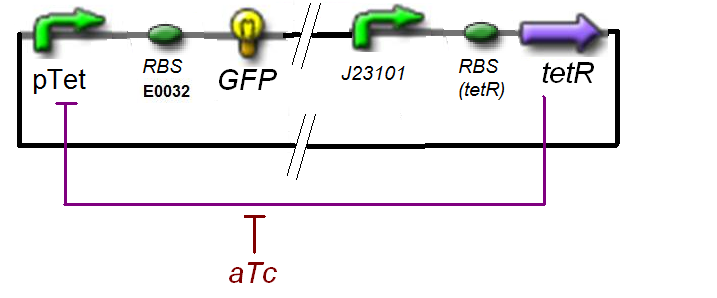Team:Paris/Modeling/f1
From 2008.igem.org
(Difference between revisions)
| Line 21: | Line 21: | ||
|nM.min<sup>-1</sup> | |nM.min<sup>-1</sup> | ||
| | | | ||
| - | |need for 20 | + | |need for 20 values with well choosen [aTc]<sub>i</sub> <br> |
| + | with 5 measures for each | ||
|- | |- | ||
|γ<sub>GFP</sub> | |γ<sub>GFP</sub> | ||
| Line 33: | Line 34: | ||
|nM | |nM | ||
| | | | ||
| - | |need for | + | |need for 100 measures |
|- | |- | ||
|(''fluorescence'') | |(''fluorescence'') | ||
| Line 39: | Line 40: | ||
|au | |au | ||
| | | | ||
| - | |need for | + | |need for 100 measures |
|- | |- | ||
|''conversion'' | |''conversion'' | ||
Revision as of 11:24, 19 October 2008
The experience would give us
Thus, at steady-state and in the exponential phase of growth :
| param | signification | unit | value | comments |
| [expr(pTet)] | expression rate of pTet with RBS E0032 | nM.min-1 | need for 20 values with well choosen [aTc]i with 5 measures for each | |
| γGFP | dilution-degradation rate of GFP(mut3b) | min-1 | 0.0198 | Time for Cell Division : 35 min. ; No degradation |
| [GFP] | GFP concentration at steady-state | nM | need for 100 measures | |
| (fluorescence) | value of the observed fluorescence | au | need for 100 measures | |
| conversion | conversion ration between fluorescence and concentration | nM.au-1 | (1/79.429) |
| param | signification corresponding parameters in the equations | unit | value | comments |
| βtet | production rate of pTet with RBS E0032 β1 | nM.min-1 | ||
| (Ktet/{coeftet}) | activation constant of pTet K20 | nM | The optimisation program will give us (γ Ktet / {coeftet} ƒ0) The literature [?] gives Ktet = | |
| ntet | complexation order of pTet n20 | no dimension | The literature [?] gives ntet = | |
| KaTc | complexation constant aTc-TetR K19 | nM | The literature [?] gives KaTc = | |
| naTc | complexation order aTc-TetR n19 | no dimension | The literature [?] gives naTc = |
Also, this experiment will allow us to know the expression of ƒ1 :
 "
"


